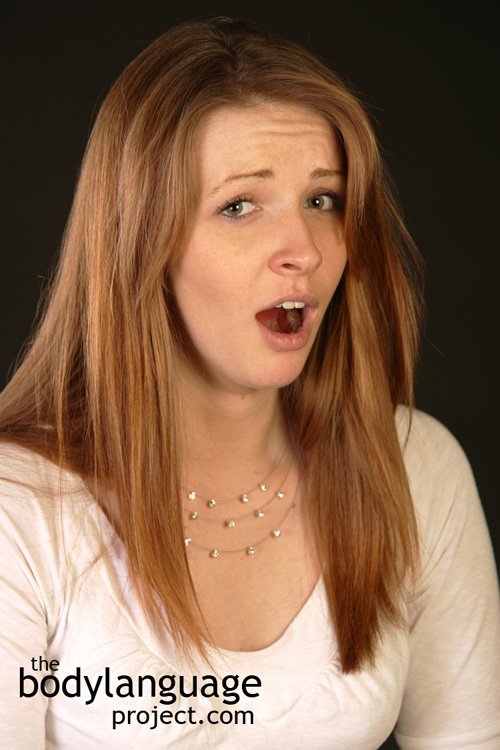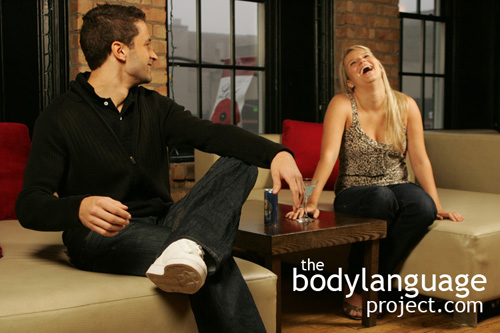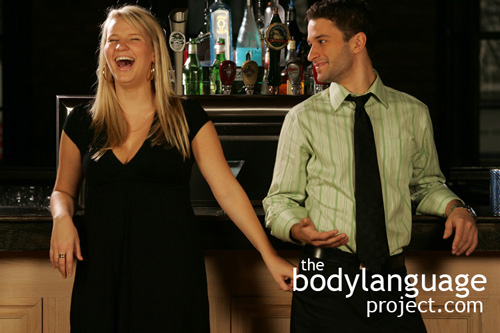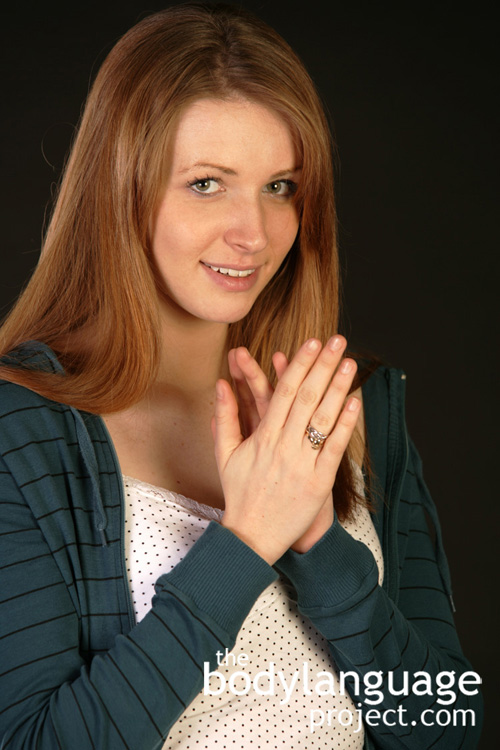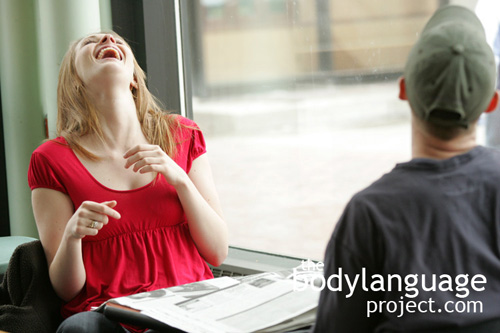Body Language of Wrench Forward Handshake
Synonym(s): N/A
Description: Unlike the thrust forward handshake, the wrench forward handshaker will pull people into their personal space. It happens during a normal handshake except that a person pulls sharply toward them. This puts the other person off balance, forcing them to fall inward.
In One Sentence: The wrench forward handshake signals that a person wants to pull another in closer so they can control them.
How To Use it: Use the wrench forward handshake to show that you are not prepared to let someone out of your sight. Tell them you are keeping a close eye on them by pulling them into your personal space. This body language serves as a fair warning that insubordination will not be tolerated.
Context: General.
Verbal Translation: “I like you so much that I’m going to pull you into my personal space so we can be more intimate, besides if you stay close I can keep a better eye on you and control you better.”
Variant: See Country Handshake (The), Cold Dead Wet Fish Handshake, Double Gripper Politician Handshake or Double Hander (The), Short Grabber/Finger Grabber Handshake, Oddball Handshake, Palm Up, Palm Down and Palm Even Handshakes, Stiff Arm And Thrust Forward Handshake, Death Grip Handshake, Wrench Forward Handshake, Undershaker Handshake, Wrist Hold Handshake, Wrist Hold Handshake and Upper Arm Grip Handshake, Limp Fish Handshake, Teacup Handshake, Arm Twister Handshake (The), Firm handshake, Fist Bumping.
Cue In Action: Bob liked Doug very much, but the sentiment was not reciprocal. When they shook hands, Doug reached out and away from his body, but as soon as Bob got a good grip, he pulled him and close almost making him fall. Doug laughed it off, but made a note to avoid shaking hands with him next time if possible.
Meaning and/or Motivation: This is done by people who require less personal space than normal.
People who shakes hands in this way are also trying to control the other person by moving them into their personal space against their will. They feel that they can influence them more efficiently by making them uncomfortable. They are also setting the other person off balance making them unable to properly respond.
Another variation exists where someone might pull you forward toward a chair, or move you to the side of the room as desired. Someone that shakes hands like this is trying to set the tone for the relationship by controlling where you move next. Obviously, this is a sign that they want to dominate you.
Cue Cluster: The wrench forward handshaker will usually find other ways to control through intimacy such as getting closer and invading personal space, touching the back arms or hands while talking and so forth.
Body Language Category: Aggressive body language, Dominant body language, Excited body language, Intimate touching, Power play, Space invasion, Social touching.
Resources:
Aström, J ; Thorell, L H ; Holmlund, U ; D’Elia, G. Handshaking, personality, and psychopathology in psychiatric patients, a reliability and correlational study. Perceptual and motor skills 1993, Vol.77(3 Pt 2): 1171-86.
Argyle, M., & Dean, I. Eye contact, distance and affiliation. Sociometry, 1965, 28, 289-304.
Boucher, Michael L. Holzberg, Jules D. (editor). Effect of seating distance on interpersonal attraction in an interview situation. Journal of Consulting and Clinical Psychology. 1972 38(1): 15-19.
Beaulieu, Catherine. Intercultural Study of Personal Space: A Case Study. Journal of Applied Social Psychology. 2004 34(4):794-805.
Cook, M. Experiments on orientation and proxemics. Human Relations, 1970, 23, 61-67.
Coutts, Larrym. ; Ledden, Maribeth. Nonverbal Compensatory Reactions to Changes in Interpersonal Proximity. The Journal of Social Psychology. 1977 102(2): 283-290.
Chaplin William F.; Phillips Jeffrey B; Brown Jonathan D.; Clanton Nancy R.; Stein Jennifer L.; 2000. Handshaking, gender, personality, and first impressions Journal of personality and social psychology. 79(1): 110-117.
Dolphin, Carol Zinner. Beyond hall: Variables in the use of personal space in intercultural transactions. Howard Journal of Communications. 1988. 1(1): 23-38.
Dolcos, Sanda ; Sung, Keen ; Argo, Jennifer J ; Flor-Henry, Sophie ; Dolcos, Florin. The power of a handshake: neural correlates of evaluative judgments in observed social interactions. Journal of cognitive neuroscience. 2012 24(12): 2292-305.
Frumin, Idan; Ofer Perl; Yaara Endevelt-Shapira; Ami Eisen; Neetai Eshel; Iris Heller; Maya Shemesh; Aharon Ravia; Lee Sela; Anat Arzi and Noam Sobel. A Social Chemosignaling Function for Human Handshaking. eLife 2015. 4:e05154
DOI: http://dx.doi.org/10.7554/eLife.05154.
http://bodylanguageproject.com/articles/shake-hands-share-human-scent-curious-case-hand-sniffing-body-language/
Fisher, J; Rytting, M and Heslin, R. 1976. Hands touching hands: affective and evaluative effects on interpersonal touch, Sociometry 39: 416–421.
Felipe, N. Interpersonal distance and small group interaction. Cornell Journal of Social Relations, 1966, 1, 59-64.
Gardin, Hershel ; Kaplan, Kalman J. ; Firestone, Ira J. ; Cowan, Gloria A. Lanzetta, John T. (editor). Proxemic effects on cooperation, attitude, and approach-avoidance in a Prisoner’s Dilemma game. Journal of Personality and Social Psychology. 1973. 27(1): 13-18.
Greenberg, Carl I. ; Firestone, Ira J. Greenwald, Anthony G. (editor). Compensatory responses to crowding: Effects of personal space intrusion and privacy reduction. Journal of Personality and Social Psychology. 1977. 35(9): 637-644.
Graziano, Michael S.A. and Cooke, Dylan F. Parieto-frontal interactions, personal space, and defensive behavior. Neuropsychologia. 2006. 44(6): 845-859.
Gueguen, Nicolas. Handshaking and Compliance With a Request – A Door-to-door Setting. Social Behavior and Personality. 2013. 41(10): 1585-1588.
http://bodylanguageproject.com/articles/handshakes-lead-compliance-study/
Greenbaum, Paul ; Rosenfeld, Howard. Varieties of touching in greetings: Sequential structure and sex-related differences. Journal of Nonverbal Behavior. 1980. 5(1): 13-25.
Holt, Daphne J ; Cassidy, Brittany S ; Yue, Xiaomin ; Rauch, Scott L ; Boeke, Emily A ; Nasr, Shahin ; Tootell, Roger B H ; Coombs, Garth. Neural correlates of personal space intrusion. The Journal of neuroscience : the official journal of the Society for Neuroscience. 2014. 34(12): 4123-34.
Haase, Richard F. ; Dimattia, Dominic J. Berdie, Ralph F. (editor). Proxemic behavior: Counselor, administrator, and client preference for seating arrangement in dyadic interaction. Journal of Counseling Psychology. 1970 17(4): 319-325.
Hiemstra, Kathleen M. Shake My Hand: Making the Right First Impression in Business With Nonverbal Communications.(Brief Article)(Statistical Data Included). Business Communication Quarterly. 1999. 62(4): 71.
Jeffrey D. Fisher; Marvin Rytting; Richard Heslin. 1976. Hands Touching Hands: Affective and Evaluative Effects of an Interpersonal Touch. Sociometry, 39(4): 416-421.
Kenner, Andrew N. ; Katsimaglis, George. Gender differences in proxemics: taxi-seat choice. Psychological Reports. 1993 72(2): 625(2).
Mcelroy, James C. ; Morrow, Paula C. Personal space, personal appearance, and personal selling. Psychological Reports. 1994 74(2): 425(2).
Mcgurk, Barry J. ; Davis, John D. ; Grehan, John. Assaultive behavior personality and personal space. Aggressive Behavior. 1981. 7(4): 317-324.
Newman, Robert C. ; Pollack, Donald Holzberg, Jules D. (editor). Proxemics in deviant adolescents. Journal of Consulting and Clinical Psychology. 1973 40(1): 6-8.
Okken, Vanessa ; Van Rompay, Thomas ; Pruyn, Ad. Room to Move: On Spatial Constraints and Self-Disclosure During Intimate Conversations. Environment and Behavior. 2013. 45(6): 737-760.
Pease, Barbara and Allan Pease. 2006. The Definitive Book of Body Language Hardcover. Bantam.
Sanda Dolcos; Keen Sung; Jennifer J. Argo; Sophie Flor-Henry and Florin Dolcos. The Power of a Handshake: Neural Correlates of Evaluative Judgments in Observed Social Interactions. Journal of Cognitive Neuroscience. 24; 12: 2292–2305.
http://bodylanguageproject.com/articles/handshake-open-body-language-powerful-nonverbal-effect-brain/
Stewart, Greg L. ; Dustin, Susan L. ; Barrick, Murray R. ; Darnold, Todd C. Zedeck, Sheldon (editor). Exploring the Handshake in Employment Interviews. Journal of Applied Psychology. 2008. 93(5): 1139-1146.
Spezialetti, Brian D. Do’s and don’ts for winning the job interview. (laboratory technicians). Medical Laboratory Observer. 1995. 27(7): 51-53.
Scherer, S. E., & Schiff, M. R. Perceived intimacy, physical distance, and eye contact. Perceptual and Motor Skills, 1973, 36, 835-841.
Scott, J. A. Comfort and seating distance in living rooms: The relationship of interactants and topic of conversation. Environment and Behavior, 1984, 16, 35-54.
Sommer, R. Studies in personal space. Sociometry, 1959, 22,247-260.
Sommer, R. The distance for comfortable conversation: A further study. Sociometry, 1962, 25, 111-116.
Sommer, R. Personal space: The behavioral basis of design. Englewood Cliffs, New Jersey: Prentice Hall. 1969.
Weiss, M., & Keys, C. The influence of proxemic variables on dyadic interaction between peers. Paper presented at the meeting of the American Psychological Association; Chicago, 1975, August.
Wesson, David A. The handshake as non-verbal communication in business. (marketing technique). Marketing Intelligence & Planning. 1992. 10(9): 61(6).
Werner, Carol ; Brown, Barbara ; Damron, Gary Steiner, Ivan D. (editor). Territorial marking in a game arcade. Journal of Personality and Social Psychology. 1981. 41(6): 1094-1104.


